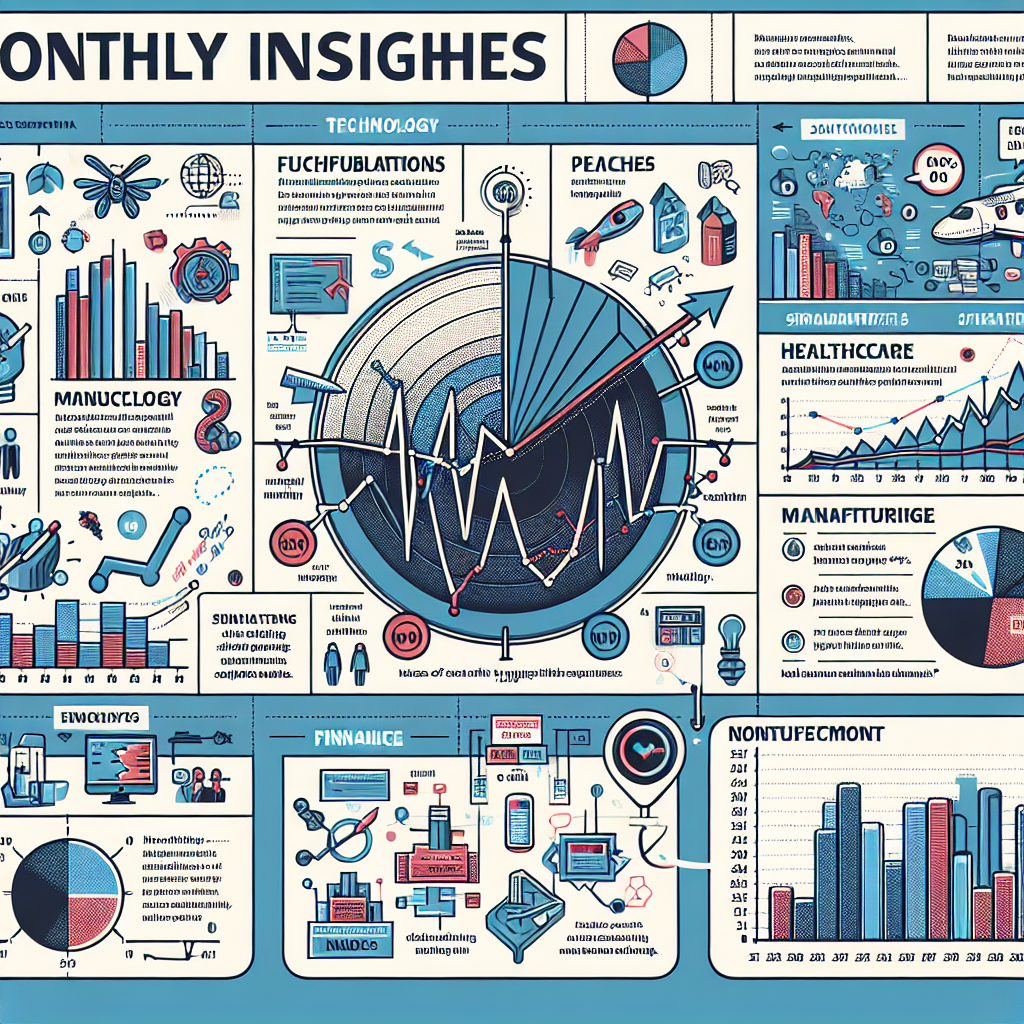“Unlocking Trends, Driving Decisions: Your Monthly Sector Analysis”
Introduction
Sector Analysis: Monthly Insights provides a comprehensive examination of various economic sectors, offering a detailed overview of their performance, trends, and potential future developments. This analysis is crucial for investors, policymakers, and business leaders seeking to understand the dynamics within different industries and make informed decisions. Each month, the report delves into key metrics, market movements, and external factors influencing sectors such as technology, healthcare, finance, energy, and consumer goods. By highlighting emerging opportunities and challenges, Sector Analysis: Monthly Insights equips stakeholders with the knowledge needed to navigate the complexities of the global market landscape effectively.
Understanding Market Trends: A Monthly Sector Analysis
In the ever-evolving landscape of global markets, understanding sector trends is crucial for investors, analysts, and policymakers alike. Each month, a detailed analysis of various sectors provides insights into the underlying forces shaping market dynamics. This month, several key sectors have exhibited noteworthy trends, reflecting broader economic shifts and consumer behavior changes.
To begin with, the technology sector continues to be a focal point of interest, driven by rapid advancements and increasing digital transformation across industries. The demand for cloud computing services, artificial intelligence, and cybersecurity solutions remains robust, as businesses prioritize digital resilience and innovation. Notably, the semiconductor industry, a critical component of the tech sector, has shown signs of recovery from previous supply chain disruptions. This resurgence is attributed to strategic investments in manufacturing capabilities and a gradual easing of global supply constraints.
Transitioning to the energy sector, there is a palpable shift towards sustainable and renewable energy sources. Governments worldwide are implementing policies to reduce carbon emissions, thereby accelerating the transition to green energy. This month, solar and wind energy companies have reported significant growth, buoyed by technological advancements and increased consumer awareness of environmental issues. However, traditional energy sources, such as oil and gas, continue to play a vital role in meeting current energy demands. The sector is witnessing a delicate balance between maintaining energy security and advancing towards sustainability goals.
In the financial sector, the focus has been on navigating the complexities of a fluctuating economic environment. Central banks’ monetary policies, inflationary pressures, and geopolitical tensions are influencing market sentiment and investment strategies. This month, financial institutions have been adapting to these challenges by leveraging technology to enhance operational efficiency and customer experience. The rise of fintech solutions, including digital banking and blockchain technology, is reshaping the financial landscape, offering new opportunities and challenges for traditional players.
Meanwhile, the healthcare sector remains at the forefront of innovation, driven by ongoing research and development efforts. The global pandemic has underscored the importance of healthcare infrastructure and the need for robust systems to address public health challenges. This month, pharmaceutical companies have made strides in developing new treatments and vaccines, while telemedicine continues to gain traction as a viable healthcare delivery model. The integration of technology in healthcare is enhancing patient outcomes and accessibility, marking a significant shift in how healthcare services are delivered.
Turning to the consumer goods sector, changing consumer preferences and economic conditions are influencing market dynamics. This month, there has been a noticeable trend towards sustainable and ethically produced goods, as consumers become more conscious of their purchasing decisions. Companies are responding by adopting sustainable practices and transparent supply chains to meet these evolving demands. Additionally, the rise of e-commerce continues to reshape the retail landscape, with businesses investing in digital platforms to reach a broader audience and enhance customer engagement.
In conclusion, this month’s sector analysis highlights the interconnectedness of global markets and the multifaceted nature of market trends. As sectors adapt to technological advancements, environmental imperatives, and shifting consumer behaviors, stakeholders must remain vigilant and responsive to these changes. By understanding these trends, investors and policymakers can make informed decisions that align with long-term strategic goals, ensuring resilience and growth in an increasingly complex economic environment.
Key Performance Indicators in Sector Analysis: Monthly Review
In the ever-evolving landscape of industry sectors, understanding key performance indicators (KPIs) is crucial for stakeholders aiming to make informed decisions. As we delve into this month’s sector analysis, it becomes evident that KPIs serve as the backbone for evaluating the health and potential of various industries. These indicators not only provide a snapshot of current performance but also offer insights into future trends and challenges. By examining these metrics, businesses can align their strategies to optimize growth and efficiency.
To begin with, financial KPIs such as revenue growth, profit margins, and return on investment remain fundamental in assessing sector performance. This month, sectors like technology and healthcare have shown robust revenue growth, driven by innovation and increased demand. The technology sector, in particular, has benefited from the accelerated digital transformation across industries, leading to higher profit margins. Meanwhile, the healthcare sector’s growth is attributed to advancements in medical technology and an aging population requiring more healthcare services. These financial indicators highlight the sectors’ resilience and adaptability in a rapidly changing environment.
Transitioning to operational KPIs, efficiency metrics such as inventory turnover and production efficiency are pivotal in understanding a sector’s operational health. For instance, the manufacturing sector has demonstrated improved production efficiency due to the integration of automation and artificial intelligence. This technological adoption has resulted in faster production cycles and reduced operational costs. On the other hand, the retail sector’s inventory turnover rates have been a mixed bag, with some companies struggling to manage supply chain disruptions. These operational KPIs underscore the importance of agility and innovation in maintaining competitive advantage.
Moreover, customer-centric KPIs, including customer satisfaction and retention rates, are increasingly gaining prominence. In the service industry, customer satisfaction scores have become a critical measure of success. This month, the hospitality sector has seen a notable improvement in customer satisfaction, attributed to enhanced service delivery and personalized experiences. Conversely, the telecommunications sector faces challenges in customer retention, as consumers demand more value and better service quality. These customer-focused indicators emphasize the need for sectors to prioritize customer experience to foster loyalty and long-term success.
In addition to these traditional KPIs, environmental and social governance (ESG) metrics are becoming integral to sector analysis. As sustainability becomes a key concern for consumers and investors alike, sectors are being evaluated on their environmental impact and social responsibility. This month, the energy sector has made strides in reducing carbon emissions, aligning with global sustainability goals. However, sectors such as fashion are under scrutiny for their environmental footprint, prompting a shift towards more sustainable practices. ESG metrics are thus reshaping the way sectors are perceived and valued in the market.
In conclusion, this month’s sector analysis highlights the multifaceted nature of KPIs in evaluating industry performance. Financial, operational, customer-centric, and ESG indicators collectively provide a comprehensive view of sector dynamics. As industries navigate the complexities of the modern market, these KPIs serve as essential tools for strategic planning and decision-making. By continuously monitoring and adapting to these indicators, businesses can not only enhance their performance but also contribute to a more sustainable and equitable future. As we move forward, the integration of advanced analytics and technology will further refine KPI measurement, offering deeper insights into sector trends and opportunities.
Sector Analysis: Monthly Insights on Emerging Markets
Emerging markets have long been a focal point for investors seeking growth opportunities beyond the more established economies. As we delve into the monthly insights on these dynamic regions, it is essential to consider the multifaceted factors that influence their economic landscapes. Emerging markets, characterized by their rapid industrialization and increasing integration into the global economy, present both opportunities and challenges for investors. This month, several key trends have emerged that warrant closer examination.
To begin with, the economic performance of emerging markets has been significantly impacted by global macroeconomic conditions. The recent fluctuations in commodity prices have played a pivotal role in shaping the economic outlook of these regions. For instance, countries heavily reliant on oil exports have experienced varying degrees of economic strain due to volatile oil prices. This volatility underscores the importance of diversification in these economies, as reliance on a single commodity can lead to economic instability. Consequently, many emerging markets are actively seeking to diversify their economic activities to mitigate such risks.
In addition to commodity price fluctuations, currency exchange rates have also been a critical factor influencing emerging markets. The strength of the US dollar, in particular, has had a profound impact on these economies. A strong dollar often leads to capital outflows from emerging markets, as investors seek safer assets. This can result in depreciating local currencies, which in turn can exacerbate inflationary pressures. As a result, central banks in these regions are faced with the challenging task of balancing inflation control with the need to stimulate economic growth.
Moreover, geopolitical developments continue to shape the economic landscape of emerging markets. Trade tensions between major economies have had ripple effects across the globe, affecting trade flows and investment patterns. Emerging markets, often caught in the crossfire of such disputes, must navigate these complexities to maintain economic stability. In response, many countries are exploring new trade partnerships and regional alliances to reduce their dependence on traditional trading partners and to bolster their economic resilience.
Furthermore, technological advancements are playing an increasingly significant role in the transformation of emerging markets. The rapid adoption of digital technologies is driving innovation and creating new business opportunities. From fintech solutions revolutionizing the financial sector to e-commerce platforms expanding market access, technology is reshaping the economic landscape. This digital transformation is not only enhancing productivity but also fostering greater financial inclusion, thereby contributing to sustainable economic growth.
In light of these developments, it is crucial for investors to adopt a nuanced approach when considering opportunities in emerging markets. While the potential for high returns is evident, so too are the risks associated with these investments. A thorough understanding of the local economic, political, and social contexts is essential for making informed investment decisions. Additionally, investors should remain vigilant to the evolving global economic environment, as changes in developed markets can have significant implications for emerging economies.
In conclusion, the monthly insights into emerging markets reveal a complex interplay of factors that influence their economic trajectories. From commodity price volatility and currency fluctuations to geopolitical developments and technological advancements, these regions are navigating a rapidly changing global landscape. As such, a comprehensive and informed approach is necessary for those seeking to capitalize on the opportunities presented by these dynamic markets. By staying attuned to these trends, investors can better position themselves to navigate the challenges and seize the potential rewards that emerging markets offer.
Monthly Sector Analysis: Identifying Growth Opportunities

In the ever-evolving landscape of global markets, identifying growth opportunities within various sectors is crucial for investors and businesses alike. As we delve into this month’s sector analysis, it becomes evident that certain industries are poised for significant expansion, driven by technological advancements, shifting consumer preferences, and regulatory changes. Understanding these dynamics not only aids in making informed investment decisions but also provides a strategic advantage in navigating the complexities of the modern economy.
To begin with, the technology sector continues to be a powerhouse of growth, fueled by rapid innovation and increasing digitalization across industries. The proliferation of artificial intelligence and machine learning technologies is transforming business operations, enhancing efficiency, and creating new revenue streams. Companies that are at the forefront of these technological advancements are likely to experience substantial growth. Moreover, the ongoing expansion of cloud computing services and the increasing reliance on data analytics further underscore the sector’s potential. As businesses strive to harness the power of data, demand for cloud-based solutions and analytics platforms is expected to rise, presenting lucrative opportunities for investors.
Transitioning to the healthcare sector, it is apparent that demographic shifts and technological breakthroughs are driving growth. An aging global population is increasing the demand for healthcare services, while innovations in biotechnology and pharmaceuticals are paving the way for new treatments and therapies. The recent focus on personalized medicine and telehealth services is reshaping the healthcare landscape, offering new avenues for growth. As regulatory frameworks evolve to accommodate these advancements, companies that can adapt and innovate are likely to thrive.
In parallel, the renewable energy sector is witnessing a surge in growth, propelled by heightened awareness of climate change and a global push towards sustainability. Governments worldwide are implementing policies to reduce carbon emissions, thereby accelerating the transition to renewable energy sources such as solar, wind, and hydroelectric power. This shift is creating a fertile ground for investment in renewable energy infrastructure and technology. Companies that are able to capitalize on this trend by developing efficient and cost-effective solutions are well-positioned to benefit from the sector’s expansion.
Furthermore, the consumer goods sector is undergoing a transformation as changing consumer preferences and digitalization reshape the market. The rise of e-commerce and direct-to-consumer models is altering traditional retail dynamics, compelling companies to innovate and adapt. Consumers are increasingly prioritizing convenience, sustainability, and personalized experiences, driving demand for products that align with these values. As a result, businesses that can effectively leverage digital platforms and respond to evolving consumer trends are likely to capture significant market share.
Lastly, the financial services sector is experiencing a wave of disruption, driven by fintech innovations and changing regulatory landscapes. The emergence of digital banking, blockchain technology, and decentralized finance is challenging traditional financial models, offering new opportunities for growth. As consumers and businesses seek more efficient and accessible financial solutions, companies that can deliver innovative services while navigating regulatory complexities are poised for success.
In conclusion, this month’s sector analysis highlights the diverse growth opportunities across technology, healthcare, renewable energy, consumer goods, and financial services. By understanding the underlying drivers of these sectors and staying attuned to emerging trends, investors and businesses can strategically position themselves to capitalize on the evolving market landscape. As the global economy continues to transform, identifying and seizing these opportunities will be key to achieving sustainable growth and long-term success.
Sector Analysis: Monthly Insights into Consumer Behavior
In the ever-evolving landscape of consumer behavior, understanding the nuances of monthly trends is crucial for businesses aiming to stay ahead of the curve. This month’s analysis reveals several key insights that are shaping the way consumers interact with products and services across various sectors. As we delve into these insights, it becomes evident that technological advancements, economic factors, and shifting societal values are playing pivotal roles in influencing consumer decisions.
To begin with, the integration of technology into everyday life continues to transform consumer behavior at an unprecedented pace. The proliferation of smartphones and the increasing reliance on digital platforms have led to a significant shift towards online shopping. This trend is not only evident in the retail sector but also in areas such as food delivery and entertainment. Consumers are increasingly valuing convenience and speed, which digital solutions readily provide. Consequently, businesses that have embraced e-commerce and digital marketing strategies are witnessing substantial growth, while those that lag behind are struggling to maintain their market share.
Moreover, economic factors are exerting a considerable influence on consumer behavior. Inflationary pressures and fluctuating economic conditions have led consumers to become more price-sensitive and value-conscious. This shift is particularly noticeable in sectors such as grocery and household goods, where consumers are opting for private labels and discount brands over premium products. Additionally, the rise of subscription-based models in various industries, from streaming services to meal kits, reflects a growing preference for predictable and manageable expenses. These models offer consumers the flexibility to tailor their spending according to their needs, thereby providing a sense of financial control in uncertain times.
In addition to technological and economic influences, societal values are also reshaping consumer behavior. There is a growing emphasis on sustainability and ethical consumption, driven by increased awareness of environmental issues and social responsibility. Consumers are more inclined to support brands that demonstrate a commitment to sustainable practices and ethical sourcing. This trend is particularly prominent among younger demographics, who are more likely to prioritize environmental impact over brand loyalty. As a result, companies across various sectors are being compelled to adopt more sustainable practices and transparently communicate their efforts to meet the expectations of this conscientious consumer base.
Furthermore, the importance of personalization in consumer experiences cannot be overstated. As consumers become more discerning, they expect brands to cater to their individual preferences and needs. This demand for personalization is evident in sectors such as fashion, where customized recommendations and tailored shopping experiences are becoming the norm. Businesses that leverage data analytics and artificial intelligence to deliver personalized experiences are gaining a competitive edge, as they can foster deeper connections with their customers and enhance brand loyalty.
In conclusion, the insights gleaned from this month’s sector analysis underscore the dynamic nature of consumer behavior. As technology continues to advance, economic conditions fluctuate, and societal values evolve, businesses must remain agile and responsive to these changes. By embracing digital transformation, understanding economic sensitivities, committing to sustainability, and prioritizing personalization, companies can effectively navigate the complexities of modern consumer behavior. Ultimately, those that succeed in aligning their strategies with these insights will be well-positioned to thrive in an increasingly competitive marketplace.
Monthly Sector Analysis: Impact of Global Events
In recent months, the global economic landscape has been significantly influenced by a series of pivotal events, each leaving its mark on various sectors. As we delve into the monthly sector analysis, it becomes evident that the interconnectedness of global markets has never been more pronounced. The ripple effects of geopolitical tensions, environmental challenges, and technological advancements are reshaping industries in profound ways.
To begin with, the energy sector has been at the forefront of these changes, primarily driven by geopolitical tensions in key oil-producing regions. The volatility in oil prices has not only affected energy companies but has also had a cascading impact on transportation and manufacturing sectors. As countries grapple with the dual challenge of ensuring energy security and transitioning to sustainable sources, investments in renewable energy have surged. This shift is further accelerated by international commitments to reduce carbon emissions, prompting a reevaluation of energy strategies worldwide.
Simultaneously, the technology sector continues to experience rapid growth, albeit with its own set of challenges. The ongoing semiconductor shortage, exacerbated by supply chain disruptions, has highlighted the vulnerabilities in global manufacturing processes. This shortage has had a domino effect on industries reliant on electronic components, such as automotive and consumer electronics. In response, companies are increasingly investing in local production capabilities and diversifying their supply chains to mitigate future risks. Moreover, the rise of artificial intelligence and machine learning is transforming business operations, offering new opportunities for efficiency and innovation.
In the financial sector, the impact of global events is equally pronounced. Central banks around the world are navigating the delicate balance between stimulating economic growth and curbing inflationary pressures. The recent fluctuations in interest rates have influenced investment strategies, with investors seeking refuge in safer assets amid market uncertainties. Additionally, the growing emphasis on environmental, social, and governance (ESG) criteria is reshaping investment portfolios, as stakeholders demand greater accountability and transparency from corporations.
Turning to the agricultural sector, climate change remains a formidable challenge. Unpredictable weather patterns and extreme events have disrupted crop yields, affecting food supply chains and driving up prices. In response, there is a growing emphasis on sustainable farming practices and technological innovations, such as precision agriculture, to enhance productivity and resilience. Furthermore, the increasing consumer demand for organic and locally sourced products is prompting a shift in agricultural strategies, with a focus on sustainability and quality.
The healthcare sector, too, is undergoing significant transformation in the wake of global events. The COVID-19 pandemic has underscored the importance of robust healthcare systems and accelerated the adoption of digital health solutions. Telemedicine, for instance, has become an integral part of healthcare delivery, offering patients greater access to medical services. Additionally, the focus on vaccine development and distribution has highlighted the need for international collaboration and investment in healthcare infrastructure.
In conclusion, the impact of global events on various sectors is multifaceted and dynamic. As industries navigate these challenges, adaptability and innovation will be key to sustaining growth and resilience. The interconnected nature of global markets necessitates a comprehensive understanding of these influences, as businesses and policymakers strive to make informed decisions in an ever-evolving landscape. As we continue to monitor these developments, it is clear that the ability to anticipate and respond to global events will define the success of sectors in the months to come.
Sector Analysis: Monthly Insights on Technological Advancements
In the ever-evolving landscape of technology, staying abreast of the latest advancements is crucial for businesses and individuals alike. This month’s sector analysis delves into the significant technological developments that are shaping industries and influencing market dynamics. As we explore these advancements, it is essential to consider their implications on both a micro and macro scale, providing a comprehensive understanding of their potential impact.
To begin with, artificial intelligence (AI) continues to be at the forefront of technological innovation. Recent breakthroughs in machine learning algorithms have enabled AI systems to process and analyze data with unprecedented speed and accuracy. This has led to significant improvements in various sectors, including healthcare, where AI is being used to enhance diagnostic accuracy and personalize treatment plans. Moreover, the integration of AI in financial services is revolutionizing risk assessment and fraud detection, offering more robust security measures and streamlined operations.
Transitioning to another pivotal area, the Internet of Things (IoT) is expanding its reach, connecting an ever-growing array of devices and systems. This interconnectedness is fostering smarter cities, where IoT-enabled infrastructure enhances urban living through efficient energy management and improved public services. In the industrial sector, IoT is optimizing supply chains and manufacturing processes, leading to increased productivity and reduced operational costs. As IoT technology becomes more sophisticated, its applications are expected to proliferate, driving further innovation and efficiency across various domains.
In parallel, the field of quantum computing is making strides, promising to redefine computational capabilities. Although still in its nascent stages, quantum computing holds the potential to solve complex problems that are currently beyond the reach of classical computers. This could have profound implications for fields such as cryptography, materials science, and drug discovery. As research and development in quantum technologies progress, it is anticipated that we will witness groundbreaking applications that could transform industries and scientific research.
Furthermore, advancements in renewable energy technologies are gaining momentum, driven by the urgent need to address climate change. Innovations in solar and wind energy, coupled with improvements in energy storage solutions, are making renewable energy sources more viable and cost-effective. This shift towards sustainable energy is not only reducing carbon footprints but also creating new economic opportunities and reshaping the global energy landscape. As countries and corporations commit to reducing emissions, the demand for clean energy technologies is expected to surge, spurring further advancements and investments in this sector.
Additionally, the rise of 5G technology is set to revolutionize communication networks, offering faster data speeds and more reliable connections. This advancement is poised to enhance mobile experiences and enable new applications in areas such as augmented reality, virtual reality, and autonomous vehicles. The deployment of 5G networks is also expected to drive innovation in industries such as entertainment, healthcare, and transportation, providing a platform for the development of cutting-edge solutions and services.
In conclusion, the technological advancements highlighted in this month’s sector analysis underscore the dynamic nature of the tech industry. As these innovations continue to unfold, they present both opportunities and challenges that require careful consideration and strategic planning. By understanding and adapting to these changes, businesses and individuals can position themselves to thrive in an increasingly digital and interconnected world. As we look to the future, it is clear that technology will remain a driving force in shaping the global economy and society at large.
Q&A
1. **What is Sector Analysis?**
Sector analysis involves evaluating the performance and potential of specific sectors within the economy or financial markets to identify investment opportunities and risks.
2. **Why is Monthly Sector Analysis Important?**
Monthly sector analysis provides timely insights into economic trends, helping investors and businesses make informed decisions based on recent developments and market conditions.
3. **Which Sectors are Commonly Analyzed?**
Commonly analyzed sectors include technology, healthcare, financials, consumer goods, energy, industrials, and utilities, among others.
4. **What Metrics are Used in Sector Analysis?**
Key metrics include growth rates, earnings reports, market share, regulatory changes, and macroeconomic indicators like interest rates and inflation.
5. **How Does Sector Analysis Affect Investment Strategies?**
Sector analysis helps investors allocate resources effectively, diversify portfolios, and capitalize on emerging trends or avoid declining sectors.
6. **What Tools are Used for Sector Analysis?**
Analysts use financial models, industry reports, economic data, and software tools like Bloomberg Terminal or Reuters Eikon for comprehensive analysis.
7. **What are the Challenges in Sector Analysis?**
Challenges include data accuracy, rapidly changing market conditions, geopolitical influences, and the complexity of predicting future trends.
Conclusion
Sector analysis involves examining various industries to identify trends, opportunities, and risks. Monthly insights provide a snapshot of sector performance, highlighting shifts in market dynamics, regulatory changes, and economic factors impacting different industries. By analyzing these insights, investors and stakeholders can make informed decisions, adjust strategies, and anticipate future developments. Regular sector analysis is crucial for staying competitive and responsive to market changes, ensuring that businesses and investors can capitalize on emerging opportunities while mitigating potential risks.





